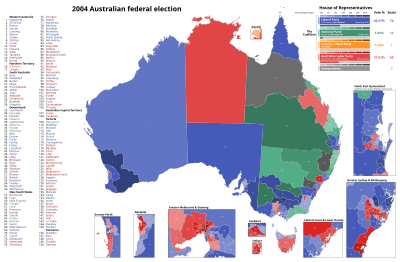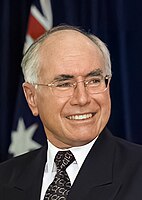| |||||||||||||||||||||||||||||||||||||||||||||||||||||||||
All 150 seats in the House of Representatives 76 seats were needed for a majority in the House 40 (of the 76) seats in the Senate | |||||||||||||||||||||||||||||||||||||||||||||||||||||||||
|---|---|---|---|---|---|---|---|---|---|---|---|---|---|---|---|---|---|---|---|---|---|---|---|---|---|---|---|---|---|---|---|---|---|---|---|---|---|---|---|---|---|---|---|---|---|---|---|---|---|---|---|---|---|---|---|---|---|
| Registered | 13,098,461 | ||||||||||||||||||||||||||||||||||||||||||||||||||||||||
| Turnout | 12,354,983 (94.32%) ( | ||||||||||||||||||||||||||||||||||||||||||||||||||||||||
| |||||||||||||||||||||||||||||||||||||||||||||||||||||||||
 Results by division for the House of Representatives, shaded by winning party's margin of victory. | |||||||||||||||||||||||||||||||||||||||||||||||||||||||||
| |||||||||||||||||||||||||||||||||||||||||||||||||||||||||
2004 Australian federal election |
|---|
| National results |
| State and territory results |
|
|
The 2004 Australian federal election was held in Australia on 9 October 2004. All 150 seats in the House of Representatives and 40 seats in the 76-member Senate were up for election. The incumbent Liberal Party of Australia led by Prime Minister of Australia John Howard and coalition partner the National Party of Australia led by John Anderson defeated the opposition Australian Labor Party led by Mark Latham.
Until 2019, this was the most recent federal election in which the leader of the winning party would complete a full term of Parliament as Prime Minister. Also until, 2022 this was the most recent federal election in which both leaders are from the same city area. Future Prime Minister Malcolm Turnbull entered Parliament in this election.

